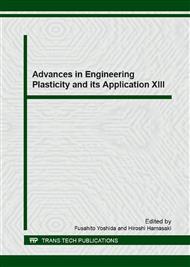[1]
W. Johnson and H. Kudo, The use of upper-bound solutions for the determination of temperature distributions in fast hot rolling and axi-symmetric extrusion processes. Int. J. Mech. Sci. 1. 2-3(1960) 175-191.
DOI: 10.1016/0020-7403(60)90038-2
Google Scholar
[2]
A. A. Tseng, A numerical heat transfer analysis of strip rolling. J. Heat. Transf. 106. 3(1984) 512-517.
DOI: 10.1115/1.3246708
Google Scholar
[3]
E. J. Patula, Steady-state temperature distribution in a rotating roll subject to surface heat fluxes and convective cooling. J. Heat. Transf. 103. 1(1981) 36-41.
DOI: 10.1115/1.3244425
Google Scholar
[4]
W. Y. D. Yuen, Effective cooling of work rolls in strip rolling. Mater. Sci. Tech. 4. 7(1988) 628-634.
Google Scholar
[5]
M. Pietrzyk and J. G. Lenard, A study of heat transfer during flat rolling. Int. J. Numer. Meth. Eng. 30. 8(1990): 1459-1469.
DOI: 10.1002/nme.1620300809
Google Scholar
[6]
K. Yamada, S. Ogawa and S. Hamauzu, Two-dimensional thermo-mechanical analysis of flat rolling using rigid-plastic finite element method. ISIJ Int. 31. 6(1991) 566-570.
DOI: 10.2355/isijinternational.31.566
Google Scholar
[7]
A. A. Tseng and F. Z. Zhao, Multidimensional inverse transient heat conduction problems by direct sensitivity coefficient method using a finite-element scheme. Numer. Heat. Transfer. 29. 3(1996) 365-380.
DOI: 10.1080/10407799608914987
Google Scholar
[8]
A. R. Shahani, S. Setayeshi, S. A. Nodamaie, M. . A Asadi and S. Rezaie, Prediction of influence parameters on the hot rolling process using finite element method and neural network. J. Mater. Process. Tech. 209. 4(2009) 1920-(1935).
DOI: 10.1016/j.jmatprotec.2008.04.055
Google Scholar
[9]
C.H. Wu, L.C. Zhang, S.Q. Li, Z.L. Jiang and P.L. Qu, A novel multi-scale statistical characterisation of interface pressure and friction in metal strip rolling. Int. J. Mech. Sci. 89 (2014) 391-402.
DOI: 10.1016/j.ijmecsci.2014.10.004
Google Scholar
[10]
G. R. Johnson and W. H. Cook, A constitutive model and data for metals subjected to large strains, high strain rates and high temperatures. Proceedings of the 7th International Symposium on Ballistics 21(1983) 541–547.
Google Scholar
[11]
J. A. Greenwood and J. B. Williamson, Contact of nominally flat surfaces. P. Roy. Soc. Lond. A. Mat. 295. 1442(1966) 300-319.
Google Scholar
[12]
M. G. Cooper, B. B. Mikic and M. M. Yovanovich, Thermal contact conductance. Int. J. Heat. Mass. Tran. 12. 3 (1969): 279-300.
DOI: 10.1016/0017-9310(69)90011-8
Google Scholar
[13]
Y. Chen, L. C. Zhang, J. A. Arsecularatne and C. Montross, Polishing of polycrystalline diamond by the technique of dynamic friction, part 1: Prediction of the interface temperature rise. Int. J. Mach. Tool. Manu. 46. 6 (2006): 580-587.
DOI: 10.1016/j.ijmachtools.2005.07.018
Google Scholar
[14]
K. A. Nuri and J. Halling, The normal approach between rough flat surfaces in contact. Wear 1975; 32(1): 81-93.
DOI: 10.1016/0043-1648(75)90206-9
Google Scholar
[15]
M. A. Meyers, Dynamic Behaviour of Materials, John Wiley & Sons, Inc., Hoboken, NJ, USA, (2005).
Google Scholar


